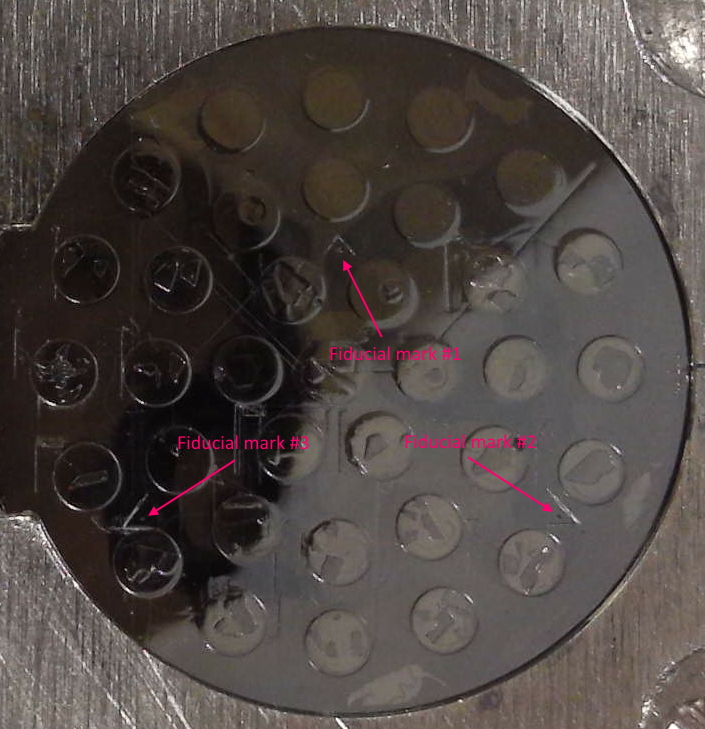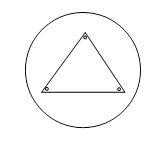For everyone's convenience here is the POS file format documentation from the Probe for EPMA reference manual, for the calibration and transformation of digitized sample positions relative to three reference or "fiducial" locations on the sample.
But it should emphasized that this fiducial transformation technique can be utilized on samples of any size or shape (not just 25mm standard mounts). In other words one doesn't require actual scribed marks on the sample, instead one can utilize any three features visible in the scanned image and which can be located on the sample once it is in the instrument. For example, cracks, corners, bubbles, mineral grains, any small features that can be easily and precisely relocated in the image and on the sample when it is mounted in the instrument.
 Fiducial Marks
Fiducial MarksThe program will ask the user whether the imported coordinates should be transformed using a fiducial based matrix transformation. The fiducial positions on the standard or unknown sample mount should generally be laid out in an easy to re-locate pattern. Generally it is preferred to place the fiducials marks in the corners of a scribed (or partially scribed- corners only) triangle on the mount surface as shown here :

The fiducial marks should be deep enough to withstand repeated re-polishing but small enough to be precise for re-location of the digitized coordinates.
A sample import file of two unknown samples and corresponding positions is shown here. Note that a new standard, unknown or wavescan sample is created automatically by the program during the acquisition process, whenever the sample number changes (for standards), or if the sample name changes (for unknowns or wavescans).
Special note: there are three varieties of formats (type = 1 or type = 2 or type = 3) used in position import and export files. The format of the position import and export file is specified by the PositionImportExportFileType parameter in the PROBEWIN.INI file. If the parameter is not specified in the INI file then the default of type = 1 is used.
The first format is the original import/export format (type = 1) and contains the fields shown in the example below without the autofocus flag and analytical setup number fields shown in parentheses at the end of the position lines.
The second format is a newer import/export format (type = 2) which contains two additional integer fields and an additional string field for each position lines. These additional integer fields are used for an auto focus flag and an analytical setup number. The analytical setup number can be used by Probe for EPMA to specify which previously saved sample setup is to be used when acquiring data for the position sample. Note that all positions in a single position sample must use the same setup number. If more than one setup number is specified within a position sample, the program will use the last analytical setup specified. If the setup number specified is not available in the current Probe for EPMA run, then the program will base the automated acquisition on the last unknown sample. The autofocus flag is used to define a "digitized" autofocus (if supported by the hardware interface) for each position. If this autofocus flag is zero, then no autofocus is attempted, if the flag is -1 or 1 then an autofocus will be attempted at that position. The adjustment from the auto-focus will be applied to all positions in that position sample.
The additional string field is used to specify a file setup name that can be used for automated designation of a file setup from an existing Probe for EPMA data file.
The importing positions with a pre-defined file setups, analytical setup numbers (and autofocus flag) are useful when digitizing position samples off-line on an optical microscope using program STAGE. However, it is important when digitizing off-line to ensure that the setup number specified during the digitizing process will eventually correspond to the correct setup number created in the Probe for EPMA run in which the digitized position samples will be automatically acquired. Also that the specified file setup data file exists and is updated with valid standardization data.
0.0, 0.0, 0.0, 0.0
0.0, 0.0, 0.0, 0.0
0.0, 0.0, 0.0, 0.0
2, 1, "metallic phase #1", 15.234, 18.12, 10.873, 1.0, 1, (1, 4, "")
2, 1, "metallic phase #1", 15.547, 18.43, 10.873, 1.0, 1, (0, 4, "")
2, 1, "metallic phase #1", 15.698, 18.56, 10.873, 1.0, 1, (0, 4, "")
2, 2, "Si3N4 ceramic matrix",15.747, 18.34, 10.873, 1.0, 1, (1, 7, "")
2, 2, "Si3N4 ceramic matrix",15.747, 18.34, 10.873, 1.0, 1, (0, 7, "")
2, 2, "Si3N4 ceramic matrix",15.747, 18.34, 10.873, 1.0, 1, (0, 7, "")
The format of these standard, unknown or wavescan position import files (the above example contains two unknown position samples with three positions each) is described below. Note that the first three lines are always used to define the coordinates of the 3 physical fiducial marks used for transformation of pre-digitized standard mounts. All parameters are comma, space or tab delimited.
Following the first 3 lines which define the x, y, z, coordinates for the three fiducial marks (used for transformation of pre-digitized standard mounts), each following position line has the following format (the fourth column is not utilized at this time) :
- the first column contains the sample type (1 = standard, 2 = unknown, 3 = wavescan)
- the second column contains the sample number, which for standards is the standard number for a standard as defined in the STANDARD.MDB database. For unknowns and wavescans it is an arbitrary number that is ignored.
- the third column is the sample name, which is optional for standard position samples and must be enclosed in double quotes
- the fourth, fifth, sixth and seventh columns contains the x, y and z coordinate positions (seventh column is not utilized at this time).
- the eighth column value is the grain number, which is used for automatically blanking the beam between successive points if different from the preceding point
- the ninth column value (only if PositionImportExportFileType = 2 or greater) is the autofocus flag, which is used for automatically performing an auto focus for each position. Specifically the third autofocus flag option (1= every sample, 2=every point, 3=digitized, 4=interval).
- the tenth column value (only if PositionImportExportFileType = 2 or greater) is the analytical setup number, which is used for automatically loading a previously created sample setup in a Probe for EPMA data file. If the specified analytical setup number is not found, the program will load a sample setup based on the last unknown sample in the run.
- the eleventh column value (only if PositionImportExportFileType = 3) is the analytical file setup name. If the specified file setup name is not found, an error is generated.
Note that standard coordinates can be imported in any order and all positions of a single standard will be appended to a single standard sample automatically. However, if a standard position sample already exists, the program will ask if the user wants to overwrite the existing standard coordinate data, so generally it is a good idea to group all coordinates for a single standard contiguously.
If no fiducial transformation of the imported positions is required, simply click "No" when asked whether to perform the fiducial transformation.
For unknown and wavescan positions these fiducial positions may be used for transformation of sample positions digitized on an optical microscope equipped with a digitizing stage using a different coordinate system than the microprobe stage. All linear transformations in scale, rotation and translation are handled. Although the use of three fiducial coordinates means that the procedure is capable of a three dimensional transformation (using x, y and z), the z coordinate transformation may be ignored, if desired by the user, for unknown or wavescan position transforms.